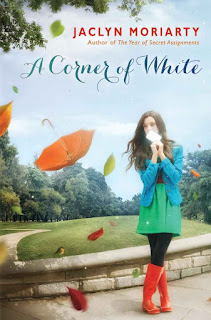Dear Aunt Debbie,
Believe it or not, I had never heard of the
Moomintrolls before reading your post earlier this week. I read it at work (Election Day professional development!), made some comment aloud, and was pounced on by my friend and colleague, and
our guest blogger, Mark. Mark fervently loves the Moomintrolls, and has promised to bring in some of Tove Jansson's books for me to borrow. I'm looking forward to it.
Back home, we're deep into
another wild, gripping chapter book which you sent Eleanor quite a little while ago, but which we hadn't picked up until this week: Eric Linklater's
The Wind on the Moon.
The reason we hadn't yet read it is mildly embarrassing, given that I'm a big reader and an English teacher to boot. It was because of the cover.
It's not like it's a bad-looking cover. It looks...sweet. Looking at this cover, you might imagine that the long novel it encases is a young coming-of-age story, perhaps about a girl who yearns poetically for something. The title does nothing to combat this impression. Of course I knew that you had sent us the book, which meant it was going to be good, but we haven't really been in the mood for sweet long novels.
Turns out that "sweet" is just about the last thing The Wind on the Moon is. It's a strange wild romp of a book, surprising at every turn, full of adventure and mystery and animals, not shying away from conflict or violence.
The story focuses on two sisters, Dinah (that's her on the cover) and Dorinda, who try not to behave badly, but can't quite help themselves. Their father, the Major, goes away at the very beginning of the book to fight a war in a far-off country, and leaves the girls with these words:
"There is wind on the moon....I don't like the look of it at all. When there is wind on the moon, you must be very careful how you behave. Because if it is an ill wind, and you behave badly, it will blow straight into your heart, and then you will behave badly for a long time to come."
The "bad behavior" the girls exhibit starts out on the Paddington Bear level: they try to help their father pack his suitcase, and end up rolling up all his clothes so they're wrinkled, and putting dirty boots on top of white shirts. Then the Major leaves, and Dinah and Dorinda's bad behavior expands. They decide that being greedy is one of the best ways to be naughty, and immediately start eating extraordinary amounts of food. Here's where the narrative starts to get surprising:
They got fatter and fatter. They got so fat, and quickly got fatter still, that every three or four days they burst their frocks and split their vests, and were quite unable to pull their stockings over their fat round legs. So every few days their mother had to buy new clothes for them. But if she bought them new dresses on a Tuesday, they were sure to burst the seams by Friday, or Saturday at the latest....By and by they grew so fat they were almost completely round, like balloons. And one day they found they could hardly walk, so they rolled downstairs and bounced into the dining-room, just as if they were balloons.
Eleanor bounced on the couch next to me in delight. Neither of us expected this! We were even more thrilled when, a few pages later, Dinah and Dorinda drink a magic potion and turn into kangaroos in order to take revenge on some nasty village children.
That's right, kangaroos.
They remain kangaroos for about 100 pages, with a plot involving a private zoo inhabited by a variety of animals with fabulous names: the ostriches Sir Bobadil and Lady Lil, the grizzly bear Bendigo, the giraffe detective Mr. Parker. There's a mystery about the theft of ostrich eggs, and a plan to free the beautiful wild Puma and Silver Falcon. We're about halfway through the book, and I have no idea where it's going next.
I have a feeling this is going to be the birthday present all of Eleanor's friends get for the next year or so. I'm about to become an evangelist for this book.
Love, Annie







